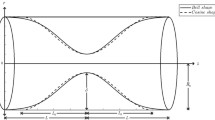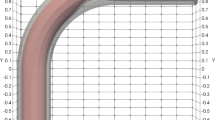Abstract
A mathematical model of the human cardiovascular system in conjunction with an accurate lumped model for a stenosis can provide better insights into the pressure wave propagation at pathological conditions. In this study, a theoretical relation between pressure drop and flow rate based on Lorentz’s reciprocal theorem is derived, which offers an identity to describe the relevance of the geometry and the convective momentum transport to the drag force. A voxel-based simulator V-FLOW VOF3D, where the vessel geometry is expressed by using volume of fluid (VOF) functions, is employed to find the flow distribution in an idealized stenosis vessel and the identity was validated numerically. It is revealed from the correlation that the pressure drop of NS flow in a stenosis vessel can be decomposed into a linear term caused by Stokes flow with the same boundary conditions, and two nonlinear terms. Furthermore, the linear term for the pressure drop of Stokes flow can be summarized as a correlation by using a modified equation of lubrication theory, which gives favorable results compared to the numerical ones. The contribution of the nonlinear terms to the pressure drop was analyzed numerically, and it is found that geometric shape and momentum transport are the primary factors for the enhancement of drag force. This work paves a way to simulate the blood flow and pressure propagation under different stenosis conditions by using 1D mathematical model.
Similar content being viewed by others
References
Westerhof, N., Bosman, F., De Vries, C.J., et al.: Analog studies of the human systemic arterial tree. Journal of Biomechanics 2, 121–143 (1969)
Anliker, M., Rockwell, R.L., Ogden, E.: Nonlinear analysis of flow pulses and shock waves in arteries. 1. Derivation and properties of mathematical model. Zeitschrift Fur Angewandte Mathematik Und Physik 22, 217–246 (1971)
Stergiopulos, N., Young, D.F., Rogge, T.: Computer simulation of arterial flow with applications to arterial and aortic stenosis. Journal of Biomechanics 25, 1477–1488 (1992)
Olufsen, M.S., Peskin, C.S., Kim, W.Y., et al.: Numerical simulation and experimental validation of blood flow in arteries with structured-tree outflow conditions. Annals of Biomedical Engineering 28, 1281–1299 (2000)
Formaggia, L., Lamponi, D., Juveri, M., et al.: Numerical modeling of 1D arterial networks coupled with a lumped parameters description of the heart. Computer Methods in Biomechanics and Biomedical Engineering 9, 273–288 (2006)
van de Vosse, F.N., de Hart, J., van Oijen C. H. G. A., et al.: Finite-element-based computational methods for cardiovascular fluid-structure interaction. Journal of Engineering Mathematics 47, 335–368 (2003)
Taylor, C.A., Figueroa, C.A.: Patient-Specific Modeling of cardiovascular mechanics. Annual Review of Biomedical Engineering 11, 109–134 (2009)
Reymond, P., Westerhof, N., Stergiopulos, N.: Systolic hypertension mechanisms: Effect of global and local proximal aorta stiffening on pulse pressure. Annals of Biomedical Engineering 40, 742–749 (2012)
Formaggia, L., Nobile, F., Quarteroni, A., et al.: Multi-scale modelling of the circulatory system: A preliminary analysis. Computing and Visualization in Science 2, 75–83 (1999)
Torii, R., Oshima, M., Kobayashi, T., et al.: Role of 0D peripheral vasculature model in fluid-structure interaction modeling of aneurysms. Computational Mechanics 46, 43–52 (2010)
Young, D.F., Tsai, F.: Flow characteristics in models of arterial stenosis. I. Steady flow. Journal of Biomechanics 6, 395–410 (1973a)
Young, D.F., Tsai, F.: Flow characteristics in models of arterial stenosis. II. Unsteady flow. Journal of Biomechanics 6, 547–559 (1973b)
Liang, F.Y., Takagi, S., Himeno, R., et al.: Multi-scale modeling of the human cardiovascular system with applications to aortic valvular and arterial stenosis. Medical & Biological Engineering & Computing 47, 743–755 (2009)
Liang, F.Y., Fukasaku, K., Liu, H., et al.: A computational model study of the influence of the anatomy of the circle of Willis on cerebral hyperperfusion following carotid artery surgery. Biomedical Engineering Online 10, 84(1–22) (2011)
Young, D.F.: Fluid mechanics of arterial stenosis. Journal of Biomechanical Engineering 101, 157–175 (1979)
Ku, D.: Blood flow in arteries. Annual Review of Fluid Mechanics 29, 399–434 (1997)
Lorentz, H.A.: Ein allgemeiner satz. die bewegung einer reibenden flussigkeit betreffend, nebst einigen anwendungen desselben (A general theorem concerning the motion of a viscous fluid and a few applications from it). Abh. Theor. Phys. 1, 23–42 (1907)
Pozrikidis, C.: Computation of the pressure inside bubbles and pores in stokes flow. Journal of Fluid Mechanics. 474, 319–337 (2003)
Magnaudet, J.: A “reciprocal” theorem for the predication of loads on a body moving in an inhomogeneous flow at arbitrary Reynolds number. Journal of Fluid Mechanics 689, 564–604 (2011)
Sbragaglia, M., Sugiyama K.: Boundary induced nonlinearities at small Reynolds numbers, Physica D 228, 140–147 (2007)
Batchelor, G.: An Introduction to Fluid Dynamics. Cambridge University Press. Chap. 4 (2000)
Noda, S., Fukasaku, K., Himeno, R.: Blood flow simulator using medical images without mesh generation. In: IFMBE Proc. of World Congress on Medical Physics and Biomedical Engineering, 36–40 (2006)
Happel, J., Brenner, H.: Low Reynolds Number Hydrodynamics. Martinus Nijhoff Publishers, The Hague, Chap. 3 (1983)
Leonard B. P.: A stable and accurate convective modelling procedure based on quadratic upstream interpolation. Computer Methods in Applied Mechanics and Engineering 19, 59–98 (1979)
Hirt, C.W., Cook, J.L.: Calculating three-dimensional flows around structures and over rough terrain. Journal of Computational Physics 10, 324–340 (1972)
Varghese, S., Frankel, S., Fischer, P.: Direct numerical simulation of stenotic flows. Part 2. Pulsatile flow. Journal of Fluid Mechanics 582, 281–318 (2007)
Woldhuis, B.: Blood Platelet Rheology in Venules and Arterioles. Rijksuniversiteit Limburg, Chap. 2 (1993)
Fukagata, K., Sugiyama, K., Kasagi, N.: On the lower bound of net driving power in controlled duct flows, Physica D 238, 1082–1086 (2009)
Author information
Authors and Affiliations
Corresponding author
Rights and permissions
About this article
Cite this article
Ji, CJ., Sugiyama, K., Noda, S. et al. An improved correlation of the pressure drop in stenotic vessels using Lorentz’s reciprocal theorem. Acta Mech Sin 31, 122–131 (2015). https://doi.org/10.1007/s10409-015-0010-z
Received:
Revised:
Accepted:
Published:
Issue Date:
DOI: https://doi.org/10.1007/s10409-015-0010-z




